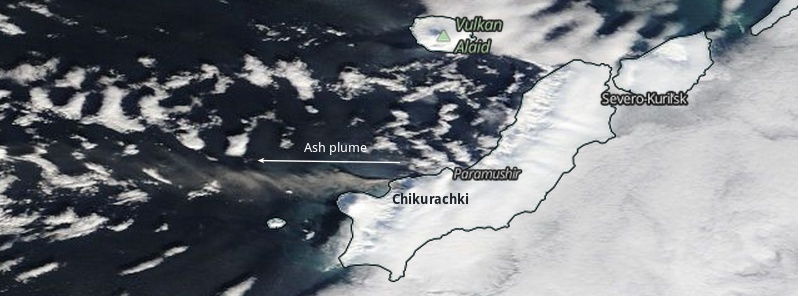Strong explosive eruption of Chikurachki volcano, Kuril Islands, Russia

A strong explosive eruption occurred at the Chikurachki volcano located on the Paramushir Island, northern Kuriles, Russia around 22:00 UTC on February 15, 2015. The last eruption of this volcano occurred in 2008.
Ash plume produced by the eruption reached an estimated altitude of 7.5 km a.s.l. It drifted west to a distance of more than 200 km. The Aviation Color Code was raised to Orange.
KVERT said they monitor Chikurachki volcano each day, but a thermal anomaly over the volcano was not registered before this eruption.
Ash explosions up to 10 km a.s.l. could occur at any time, KVERT warned and added ongoing activity could affect international and low-flying aircraft.
After Klyuchevskoy, Shiveluch, Zhupanovsky and Karymski volcanoes on Kamchatka, Chikurachki is the fifth Russian volcano currently erupting in the region, posing danger to aviation, VolcanoDiscovery reports.
The last eruptive episode of this volcano started on July 29, 2008, and ended on August 15, 2008. It had Volcanic Explosivity Index (VEI) of 2.
Geologic summary
Chikurachki, the highest volcano on Paramushir Island in the northern Kuriles, is actually a relatively small cone constructed on a high Pleistocene volcanic edifice. Oxidized basaltic-to-andesitic scoria deposits covering the upper part of the young cone give it a distinctive red color. Frequent basaltic plinian eruptions have occurred during the Holocene. Lava flows from 1781-m-high Chikurachki reached the sea and form capes on the NW coast; several young lava flows also emerge from beneath the scoria blanket on the eastern flank.
The Tatarinov group of six volcanic centers is located immediately to the south of Chikurachki, and the Lomonosov cinder cone group, the source of an early Holocene lava flow that reached the saddle between it and Fuss Peak to the west, lies at the southern end of the N-S-trending Chikurachki-Tatarinov complex. In contrast to the frequently active Chikurachki, the Tatarinov volcanoes are extensively modified by erosion and have a more complex structure. Tephrochronology gives evidence of only one eruption in historical time from Tatarinov, although its southern cone contains a sulfur-encrusted crater with fumaroles that were active along the margin of a crater lake until 1959. (GVP)
Featured image: NASA Terra/MODIS acquired February 16, 2015. Annotation: The Watchers

Commenting rules and guidelines
We value the thoughts and opinions of our readers and welcome healthy discussions on our website. In order to maintain a respectful and positive community, we ask that all commenters follow these rules:
We reserve the right to remove any comments that violate these rules. By commenting on our website, you agree to abide by these guidelines. Thank you for helping to create a positive and welcoming environment for all.